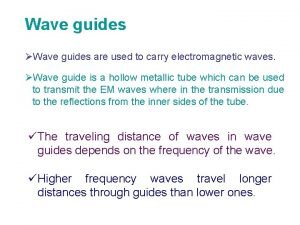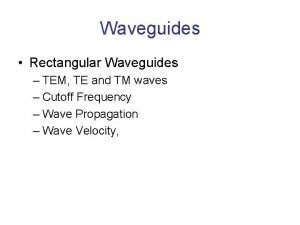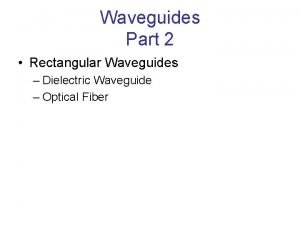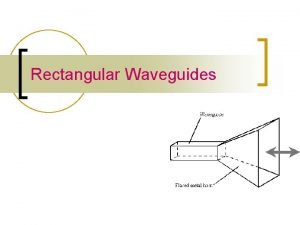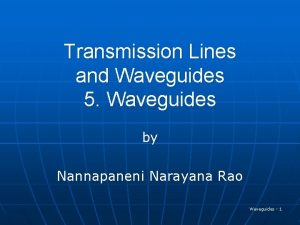Waveguides Rectangular Waveguides TEM TE and TM waves







- Slides: 7

Waveguides • Rectangular Waveguides – TEM, TE and TM waves – Cutoff Frequency – Wave Propagation – Wave Velocity, Visit for more Learning Resources

Waveguides • • • In the previous chapters, a pair of conductors was used to guide electromagnetic wave propagation. This propagation was via the transverse electromagnetic (TEM) mode, meaning both the electric and magnetic field components were transverse, or perpendicular, to the direction of propagation. In this chapter we investigate waveguiding structures that support propagation in non-TEM modes, namely in the transverse electric (TE) and transverse magnetic (TM) modes. In general, the term waveguide refers to constructs that only support non. TEM mode propagation. Such constructs share an important trait: they are unable to support wave propagation below a certain frequency, termed the cutoff frequency. Rectangular waveguide Dielectric Waveguide Circular waveguide Optical Fiber

Rectangular Waveguide • • Let us consider a rectangular waveguide with interior dimensions are a x b, Waveguide can support TE and TM modes. Rectangular Waveguide – In TE modes, the electric field is transverse to the direction of propagation. – In TM modes, the magnetic field that is transverse and an electric field component is in the propagation direction. • The order of the mode refers to the field configuration in the guide, and is given by m and n integer subscripts, TEmn and TMmn. – The m subscript corresponds to the number of half-wave variations of the field in the x direction, and – The n subscript is the number of half-wave variations in the y direction. • A particular mode is only supported above its cutoff frequency. The cutoff frequency is given by Location of modes

Rectangular Waveguide The cutoff frequency is given by Rectangular Waveguide Table 7. 1: Some Standard Rectangular Waveguide Designation a (in) b (in) t (in) fc 10 (GHz) freq range (GHz) WR 975 9. 750 4. 875 . 125 . 605 . 75 – 1. 12 WR 650 6. 500 3. 250 . 080 . 908 1. 12 – 1. 70 WR 430 4. 300 2. 150 . 080 1. 375 1. 70 – 2. 60 WR 284 2. 84 1. 34 . 080 2. 08 2. 60 – 3. 95 WR 187 1. 872 . 064 3. 16 3. 95 – 5. 85 WR 137 1. 372 . 622 . 064 4. 29 5. 85 – 8. 20 WR 90 . 900 . 450 . 050 6. 56 8. 2 – 12. 4 WR 62 . 622 . 311 . 040 9. 49 12. 4 - 18 Location of modes

To understand the concept of cutoff frequency, you can use the analogy of a road system with lanes having different speed limits.

Rectangular Waveguide • Let us take a look at the field pattern for two modes, TE 10 and TE 20 – In both cases, E only varies in the x direction; since n = 0, it is constant in the y direction. – For TE 10, the electric field has a half sine wave pattern, while for TE 20 a full sine wave pattern is observed. Rectangular Waveguide

Example Rectangular Waveguide Let us calculate the cutoff frequency for the first four modes of WR 284 waveguide. From Table 7. 1 the guide dimensions are a = 2. 840 mils and b = 1. 340 mils. Converting to metric units we have a = 7. 214 cm and b = 3. 404 cm. TE 10: TE 10 TE 01: TE 20: TE 11: For more detail contact us TE 20 TE 01 TM 11 TE 11
